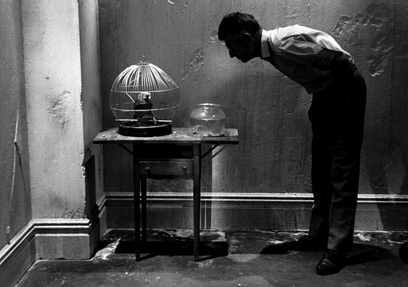science

The season in which a baby is born apparently influences the risk of developing mental disorders later in life, suggests a large new study.
The season of birth may affect everything from eyesight and eating habits to birth defects and personality later in life. Past research has also hinted the season one is born in might affect mental health, with scientists suggesting a number of reasons for this apparent effect. […]
The researchers found that all the mental disorders they looked at showed seasonal distributions. Schizophrenia and bipolar disorder had statistically significant peaks in January, and significant lows in July, August and September. Depression saw an almost significant May peak and a significant November deficit.
{ LiveScience | Continue reading }
climate, psychology | May 15th, 2012 5:38 am

In a new study, seniors in a good mood compared fewer options and made worse choices than did those in a bad mood or younger participants.
{ ScienceNews | Continue reading }
photos { Todd Fisher | Juergen Teller }
photogs, psychology | May 13th, 2012 3:55 pm

Since its publication (1859), the evolution theory of Charles Darwin has met with considerable opposition, notably from religious circles. Although scientific opposition decreased soon after, public rejection of evolution never died down. Recent research shows that a substantial part of the western world does not accept the idea of evolution. This article tries to understand the evolution controversy by reframing it as a phenomenon of public understanding of science.
Findings suggest that the decision to reject evolution does not involve scientific knowledge. Arguments drawn from science are merely viewed as an addition to a decision that is already made and serve as a rationale to a non-rational decision.
{ SAGE | Continue reading }
image { Karin }
ideas, science | May 13th, 2012 3:55 pm

The parent-offspring conflict theory delineates a zone of conflict between the mother and her offspring over weaning. We expect that the mother would try to wean her offspring off a little earlier than the offspring would be ready to wean themselves, thereby entering the zone of conflict for a short span of time. Though the theory was originally formulated in the context of weaning, it is also relevant in other contexts where a parent and his/her offspring have conflicting interests. Conflict has been reported over feeding, grooming, traveling, evening nesting, and mating in various species.
There are several theoretical models that address parent-offspring conflict in different contexts like reproduction, intra-brood competition, sexual conflict, and parental favoritism toward particular offspring. Though relatedness between parents, offspring and siblings can be measured easily, it is not easy to measure precisely parental investment and the costs and benefits to the concerned parties in nature. In some studies attempts have been made to quantify parental care in terms of milk ingested by offspring, sometimes as a correlate of weight gain by the individual pups, and sometimes by the duration of suckling. However, we have to accept that there is considerable variation in the suckling rates of individual pups, and in hunger levels of individuals, and hence such measures can only provide a rough estimate of parental investment. It is therefore not surprising that empirical tests of the theory in a field set up are sparse, especially in the original context of weaning. The parent-offspring conflict theory has in fact been claimed to be one of the most contentious subjects in behavioral and evolutionary ecology and also one of the most recalcitrant to experimental investigation.
{ arXiv | PDF }
animals, science, theory | May 13th, 2012 3:55 pm

A new study suggests that, by disrupting your body’s normal rhythms, your alarm clock could be making you overweight.
The study concerns a phenomenon called “social jetlag.” That’s the extent to which our natural sleep patterns are out of synch with our school or work schedules. Take the weekends: many of us wake up hours later than we do during the week, only to resume our early schedules come Monday morning. It’s enough to make your body feel like it’s spending the weekend in one time zone and the week in another. […]
Previous work with such data has already yielded some clues. “We have shown that if you live against your body clock, you’re more likely to smoke, to drink alcohol, and drink far more coffee,” says Roenneberg. […]
The researchers also found that people of all ages awoke and went to bed an average of 20 minutes later between 2002 and 2010. Work and school times have remained the same, meaning that social jetlag has increased during this period.
{ Science | Continue reading }
photo { Weegee in his apartment, police radio by his bedside }
health, science, sleep, time | May 11th, 2012 1:58 pm

Small children (age 4-6) who were exposed to a large number of children’s books and films had a significantly stronger ability to read the mental and emotional states of other people. … The more absorbed subjects were in the story, the more empathy they felt, and the more empathy they felt, the more likely the subjects were to help when the experimenter “accidentally” dropped a handful of pens… Reading narrative fiction … fosters empathic growth and prosocial behavior. […]
Psychologists have found that people who watch less TV are actually more accurate judges of life’s risks and rewards than those who subject themselves to the tales of crime, tragedy, and death that appear night after night on the ten o’clock news. That’s because these people are less likely to see sensationalized or one-sided sources of information, and thus see reality more clearly.
{ OvercomingBias | Continue reading }
image { Gary Stephen Brotmeyer }
books, ideas, media, psychology | May 11th, 2012 12:06 pm

Tel Aviv University research finds that smart phone users develop new concepts of privacy in public spaces. […]
Smart phone users are 70 percent more likely than regular cellphone users to believe that their phones afford them a great deal of privacy, says Dr. Toch, who specializes in privacy and information systems. These users are more willing to reveal private issues in public spaces. They are also less concerned about bothering individuals who share those spaces, he says.
{ American Friends of TAU | Continue reading }
painting { Rogier van der Weyden, Portrait of a Woman, c. 1460 }
psychology, relationships, technology | May 10th, 2012 10:09 am

The fear of being laughed at (gelotophobia) was examined in its relations to concepts from positive psychology in Austria, China, and Switzerland.
It was related to satisfaction with life and Peterson et al.’s (2005) three orientations to happiness; the life of pleasure (hedonism), life of engagement (related to flow-experiences), and life of meaning (eudaimonia).
Participants (N = 744) completed self-report measures of gelotophobia, satisfaction with life, and orientations to happiness. The results revealed that gelotophobia could be found in all three countries.
The participants exceeded cut-off points indicating gelotophobia in Austria (5.80%), China (7.31%), and Switzerland (7.23%). The fear of being laughed at was negatively related to life-satisfaction in all three countries.
Gelotophobes described themselves with lower overall estimations of their lives.
{ The International Journal for Humor Research | Continue reading }
psychology, within the world | May 10th, 2012 9:57 am

In sports, on a game show, or just on the job, what causes people to choke when the stakes are high? A new study by researchers at the California Institute of Technology (Caltech) suggests that when there are high financial incentives to succeed, people can become so afraid of losing their potentially lucrative reward that their performance suffers.
It is a somewhat unexpected conclusion. After all, you would think that the more people are paid, the harder they will work, and the better they will do their jobs—until they reach the limits of their skills. That notion tends to hold true when the stakes are low, says Vikram Chib, a postdoctoral scholar at Caltech and lead author on a paper published in the May 10 issue of the journal Neuron. Previous research, however, has shown that if you pay people too much, their performance actually declines.
{ Caltech | Continue reading }
artwork { Hong Chun Zhang }
economics, psychology | May 10th, 2012 9:45 am

Over recent years a body of research has accumulated showing the psychological benefits of nostalgia. For example, reminiscing about the past can combat loneliness and off-set the discomfort of thinking about death. Now a team led by Xinyue Zhou has shown that nostalgia brings physical comforts too, making us feel warmer and increasing our tolerance to cold.
{ BPS | Continue reading }
psychology, temperature | May 10th, 2012 9:18 am

Modernity became obsessed with analysis and the elimination of vague, ambiguous, or contradictory ideas. We fell almost completely under its sway and came to imagine that the picture of reality that such thinking provided gave us the best way to understand our world and our place in it.
It was as if we had finally found our way out of the cave and into the kind of light that Plato had thought existed with the Platonic forms. It appeared that modern thinkers had found their way out of the shadowy and mysterious realm of our actual experience and found the kind of certainty that Plato had sought.
Today, however, we are able to see that from a very different perspective because of what we know concerning the human brain. We now know that as appealing as such certainty is, it merely represents one way that the human brain is capable of thinking. Instead of the moving picture of our actual experience, we are capable of ideas that represent snap shots, which make the distances, perspectives, and relations that we actually experience appear fixed and give us the kind of clear and distinct ideas that we crave.
In the seventh book of the Republic, Plato sets forth his famous allegory of the cave. The traditional understanding interpreted it as Plato arguing that both becoming and being were real because there were two different worlds or realms of reality. One was the world of sense-data, which the Pre-Socratic philosopher, Heraclitus argued was purely a matter of becoming. In this world, nothing ever exists in a pure state of being but is always becoming something else.
Plato however, claimed that there was another world where things did exist in a pure state of being. Parmenides and several other Pre-Socratic philosophers had long claimed that the world of which Heraclitus spoke was an illusory world produced by a naïve trust in our unreliable senses and that in fact reason showed us that only being truly existed and all becoming and change was illusory. Plato agreed with both Heraclitus and Parmenides: he believed that the world of our sense data was real and not merely illusory, but there was also a world of pure being - the parallel universe that Plato would come to describe as the world of the forms.
{ The Philosopher | Continue reading }
photo { Steve Schapiro, Samuel Beckett Looking at Parrot, New York, 1964 }
brain, ideas | May 9th, 2012 7:32 am

Despite 28 years of research, there is still no vaccine that provides effective protection against HIV, and in that time around 25 million people have died of HIV-related causes. To understand why creating a vaccine is so hard, you need to understand HIV. This is no ordinary virus. […] The virus is the most diverse we know of. It mutates so rapidly that people might carry millions of different versions of it, just months after becoming infected. HIV’s constantly changing form makes it unlike any viral foe we have tried to thwart with a vaccine. […]
Vaccines train the immune system to recognise part of a virus, creating a long-term armada of antibodies that seek and destroy the invader, should it ever show its face. For HIV, the most obvious target is gp120, the surface protein that it uses to attach itself to human cells. But gp120 also constantly changes shape, making it difficult to recognise. It also comes in clusters of three that are shielded by bulky sugar molecules, hiding it from the immune system.
On top of that, HIV targets immune cells, the very agents that are meant to kill it. And it can hide for years by shoving its DNA into that of its host, creating a long-term reservoir of potential infection.
So, creating an HIV vaccine is like trying to fire a gun at millions of shielded, moving targets. Oh, and they can eat your bullets.
{ NERS/Discover | Continue reading }
photo { Nan Goldin }
health, horror, science | May 9th, 2012 6:54 am

Forget Hannibal Lecter. The movie portrayal of serial killers as deranged loners with unusually high IQs is dangerously wrong and can hinder investigations. According to the FBI, serial killers are much different in real life. For years, law enforcement investigators, academics, mental health experts, and the media have studied serial murder, from Jack the Ripper in the late 1800s to the sniper killings in 2002, and from the “Zodiac Killer” in California to the “BTK Killer” in Kansas. These diverse groups have long attempted to understand the complex issues related to serial killers. In 2005, the FBI hosted a symposium in San Antonio, Texas. This report contains the collective insights of a team of experts on serial murder. The symposium’s focus was actually two-fold: to bridge the gap between fact and fiction and to build up our body of knowledge to generate a more effective investigative response.
Much of the general public’s knowledge concerning serial murder is a product of Hollywood productions. […] Law enforcement professionals are subject to the same misinformation from a different source: the use of circumstantial information. Professionals, such as investigators, prosecutors, and pathologists may have limited exposure to serial murder. Their experience may be based upon a single murder series, and the factors in that case are generalized to other serial killers. As a result, stereotypes take root in the police community regarding the nature and characteristics of serial murders. […]
The majority of serial killers are not reclusive, social misfits who live alone. They are not monsters and may not appear strange. Many serial killers hide in plain sight within their communities. Serial murderers often have families and homes, are gainfully employed, and appear to be normal members of the community. […]
Contrary to popular belief, serial killers span all racial groups. The racial diversification of serial killers generally mirrors that of the overall U.S. population. […] Female serial killers do exist. […]
Serial murders are not sexually-based. There are many other motivations for serial murders including anger, thrill, financial gain, and attention seeking.
{ Crime | Continue reading }
photo { Keizo Kitajima }
horror, psychology | May 8th, 2012 11:04 am

If we look at how communication works we find that words and phrases have a great influence on attention. They bring into the consciousness of the listener the concepts that are uttered. This is what meaning is – the concepts that a word or phrase can steer attention towards. This is what communication is – the sharing of attention by two (or more) brains on a sequence of concepts.
So it is not surprising that it is useful to talk to oneself. What we are doing when we self-talk is to steer our consciousness. In recent paper, Lupyan and Swingley look at how self-directed speech affects searching.
{ Thoughts on thoughts | Continue reading }
Linguistics, psychology | May 8th, 2012 10:54 am

The ‘body clock’ or circadian rhythms controls things like alertness, sleep patterns, appetite and hormones, and travelling across time zones or working nights can disturb it. […]
The researchers found that two nuclear receptors (receptors that sense hormones), called REV-ERB-α and REV-ERB-β, control the circadian expression of core circadian clock and lipid homeostatic gene networks. Not getting enough sleep puts you at increased risk of obesity, diabetes and related metabolic disorders.
{ Genome Engineering | Continue reading }
genes, health, hormones, sleep | May 8th, 2012 9:49 am

{ Why identical twins differ—despite having the same DNA }
images { Walt Disney with elephant at the American Museum of Natural History }
genes, halves-pairs, science | May 8th, 2012 8:15 am

When you “lose yourself” inside the world of a fictional character while reading a story, you may actually end up changing your own behavior and thoughts to match that of the character, a new study suggests.
Researchers at Ohio State University examined what happened to people who, while reading a fictional story, found themselves feeling the emotions, thoughts, beliefs and internal responses of one of the characters as if they were their own - a phenomenon the researchers call “experience-taking.”
They found that, in the right situations, experience-taking may lead to real changes, if only temporary, in the lives of readers.
{ Ohio State University | Continue reading }
photo { Joel Sternfeld }
books, psychology | May 7th, 2012 1:44 pm

“Illusory Power Transference” is the academic name for feeling powerful due to a superficial connection to a powerful person, such as having once been in the same room.
{ OvercomingBias | Continue reading }
psychology, relationships | May 7th, 2012 1:20 pm

One of the most important things to remember when thinking about pitching is that there are huge numbers of pitches in the world. Venture capitalists hear quite a few of them. And they find the process frustrating because it is such a low yield activity (a tiny fraction of first pitches lead to subsequent diligence and even fewer of those lead to a deal). So if you want VCs to listen to you, you need to force them to listen—to break through the clutter. Doing so requires you to hack into the VC mind.
Conceptually, pitching sounds easy. You are smart. You have a great idea and you tell people with money that great idea. They’re rational; they give it to you.
But it’s not that easy. What you essentially have to do is convince a reasonably smart person to exchange his capital for your piece of paper (a stock certificate) that is really nothing more than a promise about something that may be valuable later but, on a blind statistical basis, probably won’t be. It turns out that this is difficult.
Humans are massively cognitively biased in favor of near-term thinking. VCs are no different. That’s curious, because you’d think they would have overcome it, since good long-term thinking is sort of the entire nature of venture capital. But humans are humans. VCs are just sacks of meat with the same cognitive biases as everyone else. (…)
You must address both sides of their brains; you have to convince VCs that your proposal is economically rational, and then you must exploit their reptilian brains by persuading their emotional selves into doing the deal and overcoming cognitive biases (like near-term focus) against the deal. You should also offer VCs entertainment. They see several pitches a day (most bad) and that gets boring. Be funny and help your cause. In the tech community, even one joke will suffice.
{ Blake Masters | Continue reading }
synthetic polymer paint on paper { Mike Kelley }
economics, guide, psychology | May 7th, 2012 11:59 am

Poltergeists are defined as paranormal, mischievous ghostly presences that appear to a select group of people. As paranormal entities, they are beyond investigation by rational scientific means. Or are they? Odd sensations, visions, felt presences, out-of-body experiences, etc. have all been explained by unusual brain activity. Hence, neuroscientists should consider that poltergeists exist in the mind of the perceiver, not as a physical reality in the external world.
A new paper by parapsychologist William G. Roll and colleagues reported on the case of a woman who experienced paranormal phenomenon after suffering a head injury. (…)
[After the head injury,] …the relationship with her first husband deteriorated because he insisted she was not the same person. According to her reports one night he tried to kill her. The anomalous phenomena began that night and have been intermittent since that time. Their intensity and frequency have increased during the last 2–3 years.
EEG recordings revealed chronically abnormal activity at a right temporal lobe electrode.
{ The Neurocritic | Continue reading }
brain, incidents, neurosciences, relationships | May 7th, 2012 11:54 am






















